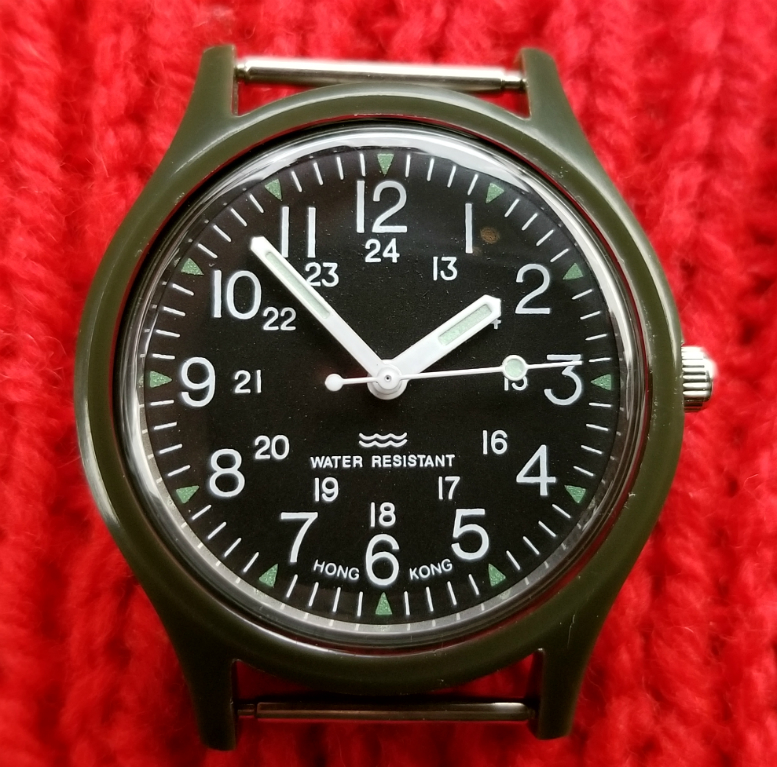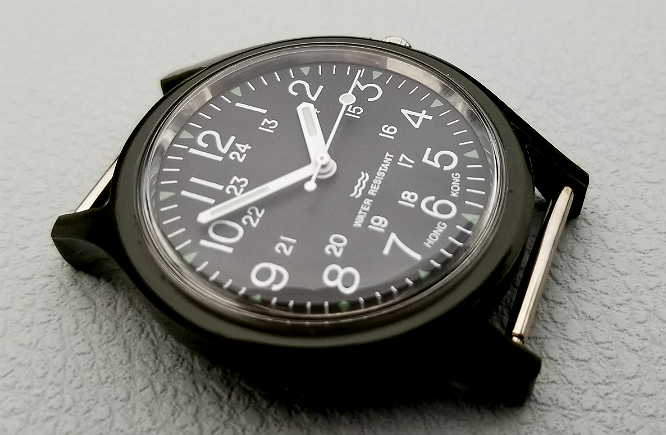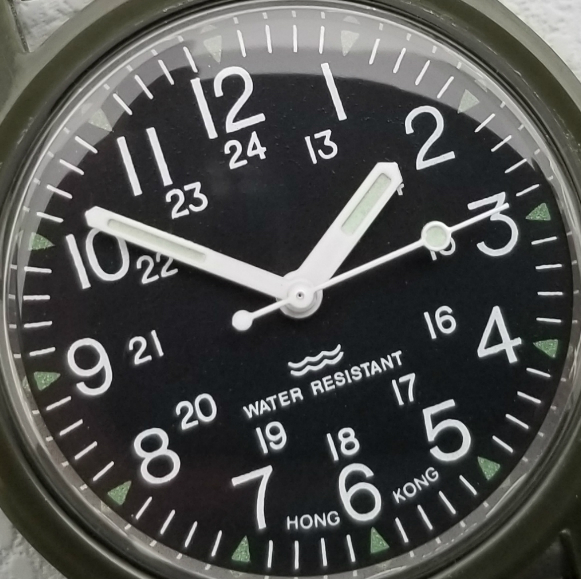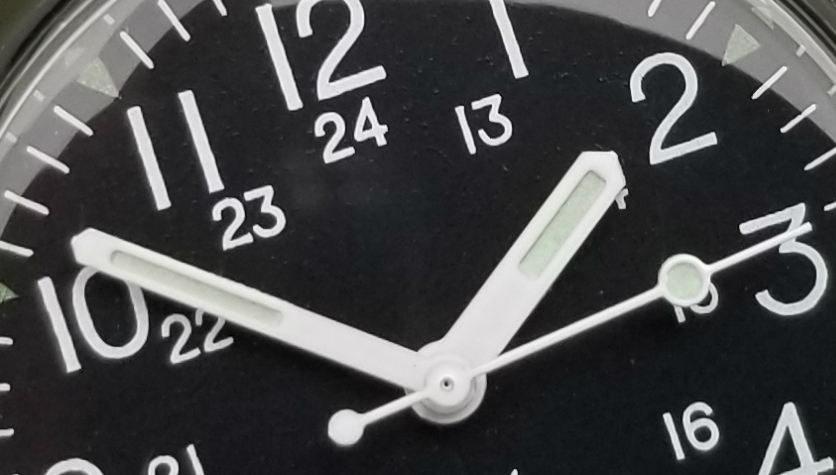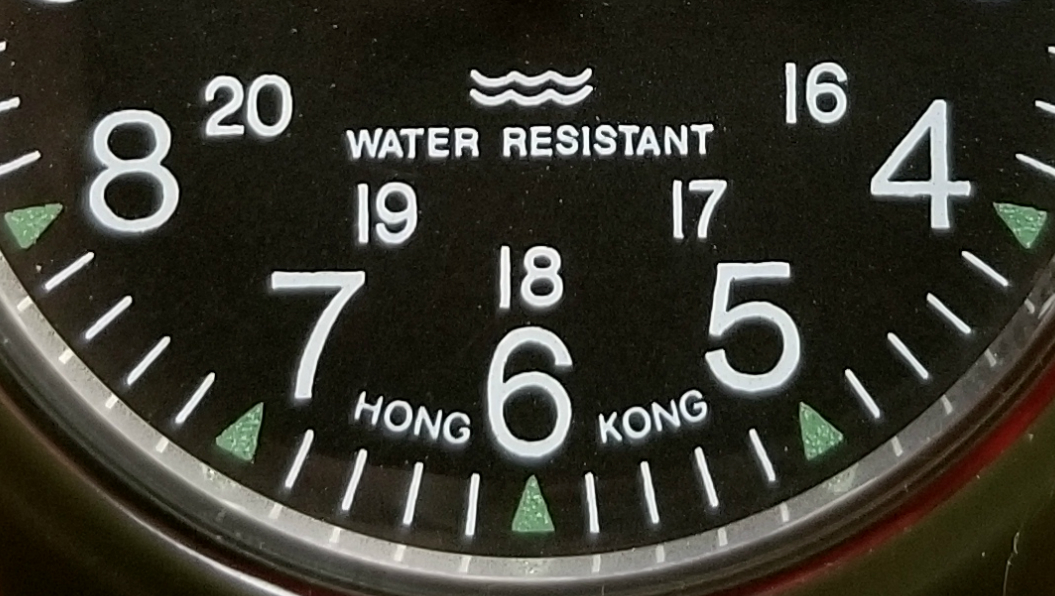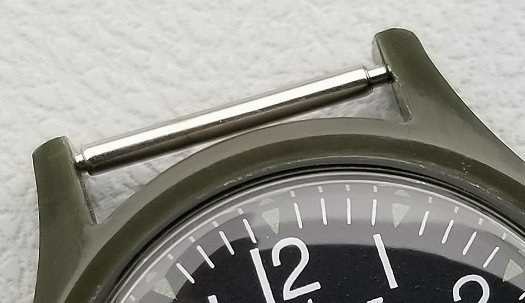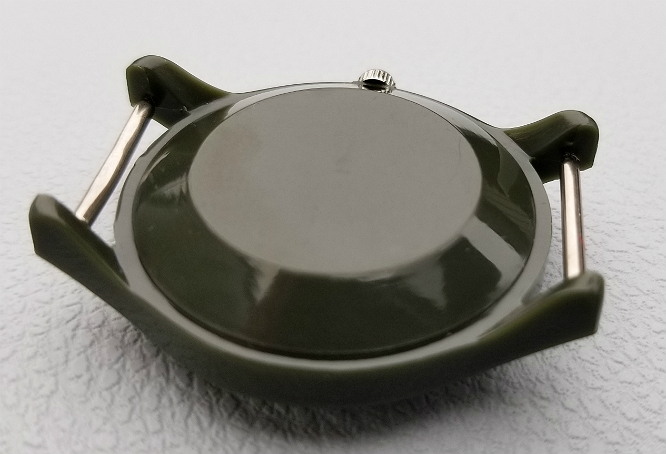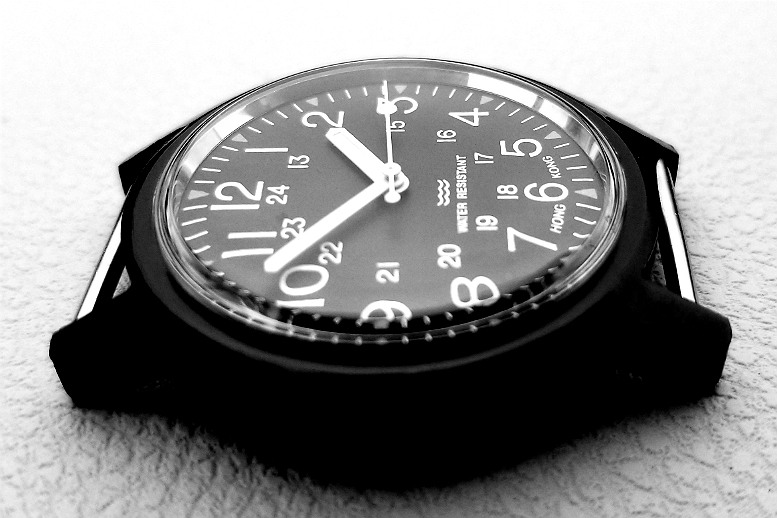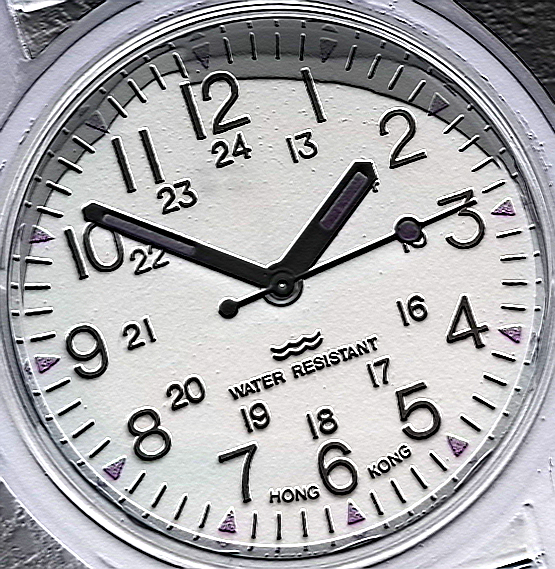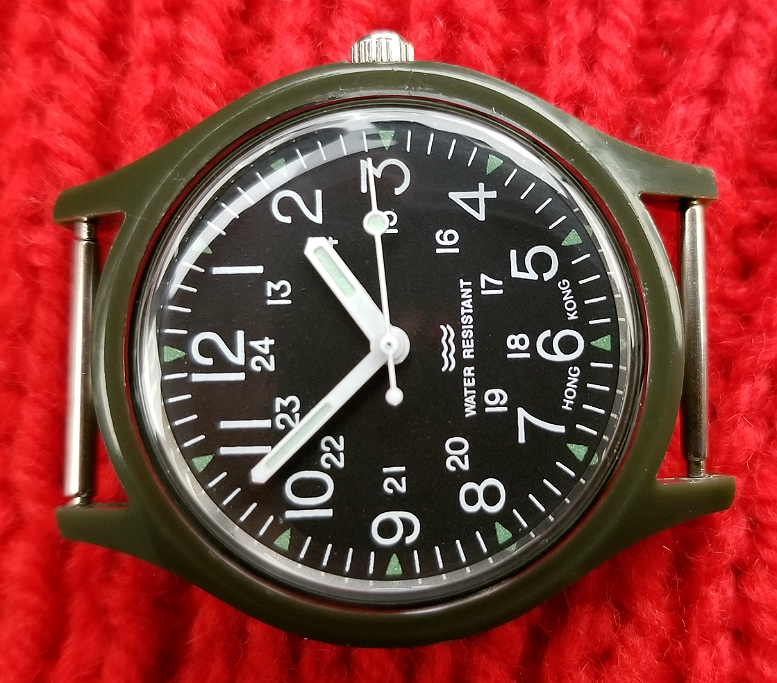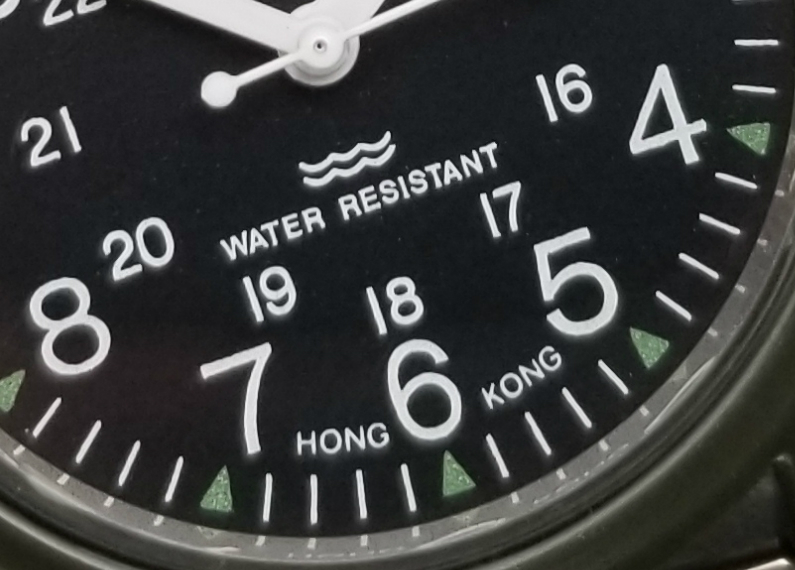Fake Timex Camper Watch, 1980s?
Mechanical watch made in Hong Kong, very much wants to look like a Camper!
end/
Hi, this is Alan. Thanks for reading, and for your interest in these reviews. My contact info is below. So, here is a kind of "bootleg" watch from Hong Kong that is not made by Timex, but is trying very hard to look like the classic Timex Camper Watch that had a long and very successful run from 1983 to ? 1994 or so.
Strictly speaking I guess I cannot call it a "fake" in that it does not have TIMEX on the dial and therefore cannot be said to be telling a potential customer that it is a Timex watch.
Much about the watch is like the Camper, and much of it isn't. Beginning with the dial, the most specifically Timex thing is the WAVE symbol, for water resistance. This symbol first appeared on Timex in the early 1980s, maybe as early as 1981 or 1982, and i can't imagine that it isn't trademarked, or otherwise somehow Timex intellectual property. In fact, if you look at the early Campers, before the WATER RESISTANT line went away, they all had this appearance, the WAVE just above the WR liine. the proportions of the wave, and the lettering are slightly off, but very close, especially the lettering.
The lettering for the hour numerals is also very close to the real Campers. The 4 has a pointed top, while the real Campers have a flat top to the 4. I'm sure typography experts can tell you other differences, but it's pretty good. The green triangles peripheral to the 1-12 hours are just a bit smaller, and instead of a cream white color, are green. These triangles are not luminous, while the true Camper has luminous markers. Then there is the obvious lack of TIMEX at the top of the dial below 12/24. Finally, HONG KONG at the bottom.
Hand are not bad, but the second hand hand has notable differences from the original. Firstly, the original seconds hand did not have the short "counterweight" segment. Also, the luminous "lollipop" is supposed to be at the very end of the seconds hand, with no needle extending beyond it. Here, the "lollipop" is shifted back a bit. The hour and minute hands are closer to true, but probably shorter. All hands have working (but poorly lasting) luminous material. Notice in this pic, the glaringly obvious lack of TIMEX on the dial!
I'm going to talk about the case, as the case is interesting. But first I want to talk a bit about watch manufacturing in Hong Kong. HK has a long history of watch assembling, which evidently began in the 1930s primarily making watch straps for the worldwide watch trade, and shipping them everywhere. Watch case manufacture followed to supply the worldwide watch trade. Eventually they began assembling complete watches for sale and export, with all parts made in Hong Kong, withe the exception of the movement. Movements, usually inexpensive low-jewel or no-jewel pin lever movements, were purchased from Germany, Switzerland and the Soviet Union. However, at some point Hong Kong began to manufacture their own mechanical movements.
This watch has a mechanical movement (not running) but I have not seen, it and do not know it's origin.
The case is kind of interesting. Notice that is uses springbars, and traditional lugs. The real Camper, of course has "solid lugs" in that a solid bar of resing goes across between the lugs, holding the watch to the strap. I'm not sure why, if they were trying their best for authenticity, that they didn't replicatre the solid lugs. Maybe they were unable to fabricate it that way. The case is made of a kind of plastic or resin, of a similar olive drab color. BTW, what is olive drab? Haha, it depend on who you ask:
"Dull olive-green colour."
"A shade of greenish-brown."
"A dark gray-green."
A grayish olive to dark olive brown or olive gray."
"A dull but fairly strong gray-green color."
View from the back of the case. It appears to be identical size to the real Camper, 36 mm. The morphology the the lugs, the way they flare out at the ends, is similar. Caseback is a solid piece to the case; there is no openable caseback. The back is flat and smooth/shiny. The very earliest Campers which were made in Taiwan also smooth, but these are uncommon, as most have a kind of roughened, or textured back, with a small central depression where I believe the mold is injected. There is absolutely nothing written on the back.
The seller was able to tell me very little about these. She came across a batch of maybe 30 of these, all apparently never used, in good physical condition, but all non-running.
(Just goofing around with the photo editor....)
What do I think of all this? Why make a bootleg of a watch that sold for $20. You'll see people asking this a lot. Google "fake timex" and you'll find people on Reddit and other places saying it makes no sense to make a fake Timex, no one would do it, it wouldn't be worth it, etc.
But this is from the mindset of watch people, who will often hear of fake Omegas Seamaster 300s, and other "luxury" fakes where you can sell it for a lot of money, and then think, well, the big price tag would seems to justify the effort if the faker can get good money for it. Luxury fakes seem to make sense to people.
Consider the Post-It Note. (Pretend, for the sake of it, that this is before 3M's patent expired.) Now, Imagine someone decides they want to make counterfeit Post-It-Notes, and they can make 17 cents profit on every unit of fake notepad they sell. The product sells for 40% less than the authentic 3M product. These cheaper fake items might be attractive to those in charge of making purchase orders for large corporations, schools, research places, whoever uses Post-Its. If the counterfeiting company sells what to them would be a "good number" of units of Post-Its, at 17 cents profit per unit, they could have a successful business.
So fakes don't have to be high-priced luxury items to make business sense, to the fakers. And that is what I think is going on with this watch. The assembler figures, if I sell this watch at a lower price, maybe even half the price of a Camper, I'll probably capture the market of consumes who might not want to, or simply be able to, spend X amount of dollars for the real deal, but they would spend X/2 dollars. And I've calculated my profit to be 27% of retail price, per watch, and if i move enough watches in a production run, say Y number of watches, well, that's good enough for us.
Another potential co-factor is that the actual Camper Watch may not have been available in some markets. Certainly today, certain Timex models are available in some markets and not in others. So, maybe the Camper Watch's popularity eclipsed its availability? Maybe it wasn't available in places where people wanted it, and some business people who were paying attention, thought, hey maybe we can make something that is close enough, and capture this market.
I do agree with the ebay seller that this was made in the 1980s, or early 1990s. If it was made after that, it would be much more likely to have a battery-powered quartz movement. The key feature to the movement was that it had to be cheap. Given the mechanical movement inside, it had to be 80s or early 90s.
I do wish two things about this:
1. I wish it was running (movement is all seized up)
2. I wish I knew anything about the movement.
Thanks for reading.
I hope you will like it
Alan
Contact:
Website: Alan's Vintage Watches
